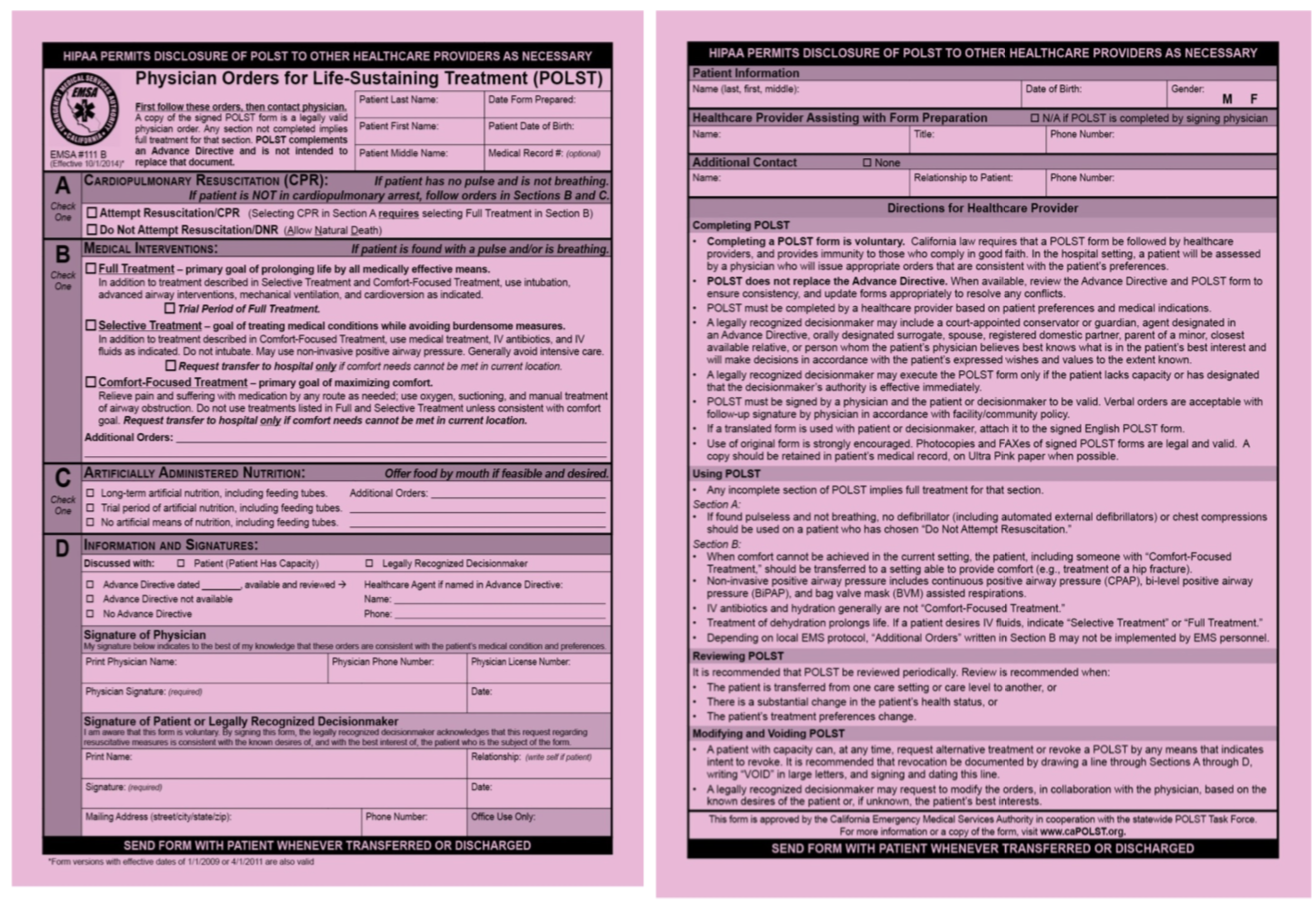By: Editorial Team | Posted: September 27, 2019 | Updated: April 5, 2023
POLST forms (also called MOLST, MOST, POST or TPOPP in various different states) are “Physician Orders” that help determine how clincians treat a person in various end-of-life type situations.
Specifically, POLST stands for “Physician Orders for Life-Sustaining Treatment”.
In this article we dig into exactly what these Physician Orders are, how you use them, and how you get help understanding them. This is the third part of a series on end of life planning. The first part of the series is here: End of Life Planning.
POLST, MOLST: What are they? Who needs one?
The (Pink) POLST Document
Basically, a POLST form is a document in which you and your physician document some specific details of how you will and will not be treated during serious, potentially life ending situations.
The POLST form is usually a bright color, often but not always “pink”.
According to Wikipedia (1), “POLST began in Oregon in 1991 and currently exists at some level in 42 [US] states and meets the national POLST standard in 18 states.
The POLST document is a standardized, portable, brightly colored single page medical order that documents a conversation between a provider and a patient with a serious illness or frailty towards the end of life. A POLST form allows emergency medical services to provide treatment a patient wants before possibly transporting a patient to an emergency facility.”
Different states in the USA have different variations on these Physician orders, sometimes with different names. According to Wikipedia, these variants include “Medical Orders for Life-Sustaining Treatment (MOLST), Medical Orders on Scope of Treatment (MOST), Physician’s Orders on Scope of Treatment (POST) or Transportable Physician Orders for Patient Preferences (TPOPP).
This article applies to the USA. There may well be non-US equivalents of POLST, but we have not researched them. Feel free to share what you know in the comments.
What Are They For?
As described by the National POLST Paradigm (2):
“The POLST form tells emergency personnel what treatments the patient wants in the event of a medical emergency.
The current standard of care during an emergency is for emergency medical services (EMS) to attempt everything possible to attempt to save a life.
Not all patients who are seriously ill or frail want this treatment and the POLST Paradigm provides the option for them to: (1) confirm this is the treatment they want or (2) to state what level of treatment they do want.”
The Treatments You Do NOT Want
Much of the POLST / MOLST form deals with treatments you do NOT want (such as “Do Not Resuscitate”).
For example, the specific sections on the California POLST form deal with what types of treatment you do or do NOT want in situations like:
- If a patient has no pulse and is not breathing;
- If a patient is found with a pulse and/or is breathing;
- Should a patient be given artificial nutrition?
Who Needs a POLST?
The advice of the experts who talked with our explorers was that these POLST / MOLST forms are usually not appropriate unless you are approaching the end of your life, but that at that point they are extremely desirable.
This is especially the case if you do not want EMS to “attempt everything possible to attempt to save your life” in some situations.
POLST vs Advance Directive
As we explain in “End of Life Planning” (the first of this three part series), “The POLST / MOLST form (Physician Order) arises from a discussion between you and your doctor. It is signed by the doctor (quite a different concept than an advance directive that you develop with your friends, family, or maybe a lawyer).”
Because a POLST form is a direct instruction to clinicians, signed by a doctor, it has a great deal of weight when the healthcare system comes to make its decisions about how you will be cared for. In contrast, an advance healthcare directive, which is not signed by a physician, is really an expression of your wishes, and may not carry the same weight with the healthcare system.
Another key aspect of these Physician Orders (POLST) seems to be that they are more precise than many advance directives.
Advance Directives can do some things that POLST forms cannot do, such as designate a person to make decisions on your behalf, and give broad instructions to that person and others as to how you want to be cared for, and wishes regarding end of life that can include care treatments but can also include a variety of spiritual and emotional things too. (For more details about Advance Directives see Advance Directive: Forms, Apps, & Online Guides.
So, some key learnings from our exploration are:
- you definitely need an advance directive; and
- if you are the sort of person who needs a POLST, then you need a POLST as well as an advance directive.
Getting and Completing a POLST Form
The POLST form is a US concept, and this article applies to residents of the USA. The POLST and related programs vary from state to state, with some states not having such a thing at all. You can see the state-by-state status of POLST at this map on the National POLST Paradigm website.
By clicking on a state, you find a link that will tell you more about the POLST program in that state. On many (perhaps all) of the state POLST websites, you can download a POLST form.
Completing the form requires you first to make some key decisions about what you want in terms of care in an emergency. The process of thinking through these issues is very much the same as for thinking through what to put in an advance healthcare directive.
We go into more detail about the numerous helpful resources available for thinking through “what you want” in Advance Directive: Forms, Apps, & Online Guides. Read those suggestions for how to make the decisions for a POLST form too.
We recommend you complete an advance directive first. You will then be in a good position to dive into the more precise questions in the POLST form.
Finally, the POLST form itself is meant to be completed in consultation with your physician, and signed by that physician. So the final step is to have a discussion about the POLST with your physician. And we are told that physicians should have copies of the actual POLST form to give you.
To Be Useful, POLST Needs to be Available
The experts we talked to, and the various online resources, all point out that a POLST needs to be available to be useful.
Some people suggest you should carry a POLST with you when you travel, and perhaps at all times in certain cases. It’s a good idea to make sure your healthcare providers have copies of course. And there are various programs that encourage you to keep a copy on your fridge door, for emergency personnel to find.
Increasingly, people are talking about the idea of having some type of registry that keeps your POLST and advance directives online, and easily available for a variety of healthcare providers.
These registry ideas seem still somewhat immature, but sound like the direction one would like to see for the future. We evaluate them further in the companion article on advance directives.
In addition, there are some state-specific POLST registries under development, and you can search POLST in your state to learn more.
Learn More & References
(3) Find the status of POLST for your State (USA).
*Disclosure: The research and opinions in this article are those of the author, and may or may not reflect the official views of Tech-enhanced Life.
If you use the links on this website when you buy products we write about, we may earn commissions from qualifying purchases as an Amazon Associate or other affiliate program participant. This does not affect the price you pay. We use the (modest) income to help fund our research.
In some cases, when we evaluate products and services, we ask the vendor to loan us the products we review (so we don’t need to buy them). Beyond the above, Tech-enhanced Life has no financial interest in any products or services discussed here, and this article is not sponsored by the vendor or any third party. See How we Fund our Work.

